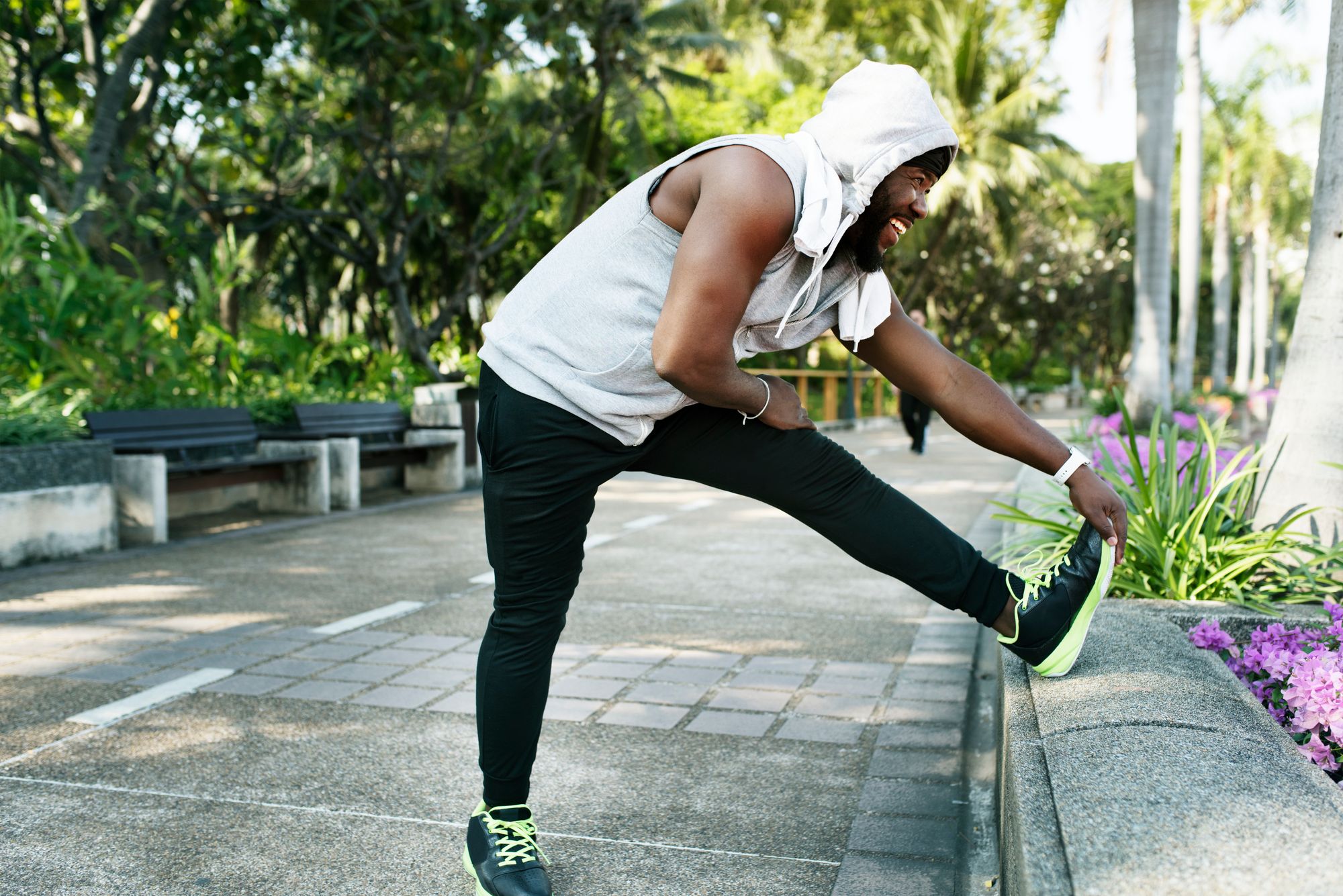Injury-Related Chronic Pain: What Is It and How to Train Through It
You're supposedly "fully healed". So, why do you still feel pain around the injury site when training? Answer: chronic pain. Find out more here.

Maybe you’ve pulled your lower back on squats. Or came close to a slipped disc on deadlifts. Or snapped a chest fiber (or two) on the bench press.
And yet … even though it's been months since your doctor has closed your case file with a "Patient made a full recovery and is cleared for exercise" remark, you still feel pain in your lower back/chest whenever performing those offending movements.
What's going on? Is there something seriously wrong with your form on those exercises—and, more importantly, should you ax them out of your training plan?
Wow. So many questions. But let's answer the last: no, you probably shouldn't ax these "problematic" exercises out of your training plan. Especially if you enjoy doing them or they're essential in helping you achieve your fitness goals.
But why’s that? Well, that’s what the rest of this article is for.
What’s chronic pain?
You're likely familiar with what chronic pain feels like for you. While its intensity may vary (i.e., it may be a dull ache on some days, but a sharp, shooting pain on others), one thing doesn't: its persistence.
It’s always there, for months on end—like some psycho ex-lover you find holding a pair of binoculars across your driveway.
And there we have it: the key defining trait of chronic pain. Not the psycho ex-lover bit, but the “months on end” part. More specifically, there are primarily two types of pain we experience:
? Chronic pain: Defined as pain that lasts for over three months. It continues long after you recover from an injury—and, most mysteriously, may even happen for no apparent reason.
Understanding chronic pain
So, obviously, your chronic pain isn't unexplained. There's a nearly 90% chance that it's due to your past injuries. But the most crucial question here is: why are you still feeling pain if you’ve already healed?
To understand that, you'll first have to know how pain works.
First things first: your body contains pain receptors (i.e., nociceptors) that detect potentially dangerous changes in temperature, chemical balance, or pressure. These pain receptors then transmit these alerts to the brain. Note the keyword here: “alerts”.
Pain receptors do not send pain to the brain. Instead, all they send are signals—meaning your brain must make sense of these signals, then make pain (based on its judgment).
And yes, to answer your question: your brain can get things wrong. It can make you feel pain even in the absence of any real threat.
A prime example of how wrong the brain can be is phantom limb pain, a well-documented phenomenon when a person who had had a leg amputated feels pain in the foot—even though they no longer have a foot.
In actuality, the pain system is incredibly complicated. It's tied up with emotions, feelings, and what the pain means to you.
How pain science applies to you, specifically
Now, back to the chronic pain you’ve been experiencing on your lifts.
At the risk of sounding dismissive (trust me, that's the last thing we'd mean to do), the chances are that your pain results from your fear.
Your body switches to “high-alert” simply because of how fearful and worried you are about executing the movement. And that “sensitizes” your pain system—your brain will read even the slightest discomfort as pain.
This, in turn, kickstarts your descent into a “pain loop”:
2️⃣ Your body goes on high alert
3️⃣ You perform the movements and feel a slight discomfort
4️⃣ Your brain reads that discomfort as pain (it's highly sensitized)
5️⃣ Repeat #1
Eventually, you'll be in so much pain that you'll either severely cut down on your range of motion or swear off those exercises (e.g., squats, deadlifts, RDLs, bench press …) forever.
By the way, find out if more range of motion is always better here:

Chronic pain management
But is there a better alternative, though? Well, yes, there is. And it all starts with the mind.
Instead of approaching the exercises with fear, trepidation, and expectations of experiencing pain, do so with a positive attitude.
Understand that you will have to work through a “comfortable level of pain” to desensitize your pain pathways.
In some sense, this works off the same principles as "exposure therapy", a psychological treatment developed to help people confront their fears.
Of course, at this point, you’re probably thinking: “Does it work, though?”
? Here's a 2021 study published in the Journal of Pain to answer your question. While far from a conclusive stand, the researchers have highlighted the effectiveness of counterconditioning procedures (i.e., exposure therapy) in reducing pain.
? There’s also this 2021 study, which found pain reprocessing therapy—compared to placebo treatment—to significantly reduce participants’ experience of chronic back pain.
Suffer from chronic lower back pain? This article might help:

Considering that, it’s only fair to say that working through your pain will be beneficial for you, with the following prerequisites:
- Your doctor and/or physical therapist has cleared you for exercise (i.e., you’re fully healed)
- There are no serious issues with your form (get it checked out by a licensed personal trainer)
- You are mentally ready to give it a shot (nobody can force you!)
Takeaway
Beyond simply working through existing pain, you should also carefully evaluate your existing training plan for any potential injury-exacerbating “shortfalls”.
Are you dedicating nearly equal volume to opposing muscle groups?
Are you resting adequately between sessions?
How’s your recovery between sessions?
Are you giving yourself ample rest time between sets, so you're performing each safely?
PS: Check out more injury-prevention tips here:


Not sure how to evaluate your training plan? Don’t even have a structured training plan in the first place? Well, why not let GymStreak help? This smart, AI-powered workout planner app will help tailor your program to your unique needs and fitness goals.
References
Ashar, Y. K., Gordon, A., Schubiner, H., Uipi, C., Knight, K., Anderson, Z., Carlisle, J., Polisky, L., Geuter, S., Flood, T. F., Kragel, P. A., Dimidjian, S., Lumley, M. A., & Wager, T. D. (2022). Effect of Pain Reprocessing Therapy vs Placebo and Usual Care for Patients With Chronic Back Pain: A Randomized Clinical Trial. JAMA Psychiatry, 79(1), 13–23. https://doi.org/10.1001/jamapsychiatry.2021.2669
Bonezzi, C., Fornasari, D., Cricelli, C., Magni, A., & Ventriglia, G. (2020). Not All Pain is Created Equal: Basic Definitions and Diagnostic Work-Up. Pain and Therapy, 9(Suppl 1), 1–15. https://doi.org/10.1007/s40122-020-00217-w
Fillingim, R. B. (2017). Individual Differences in Pain: Understanding the Mosaic that Makes Pain Personal. Pain, 158(Suppl 1), S11–S18. https://doi.org/10.1097/j.pain.0000000000000775
Gatzounis, R., den Hollander, M., & Meulders, A. (2021). Optimizing Long-term Outcomes of Exposure for Chronic Primary Pain from the Lens of Learning Theory. The Journal of Pain, 22(11), 1315–1327. https://doi.org/10.1016/j.jpain.2021.04.012


